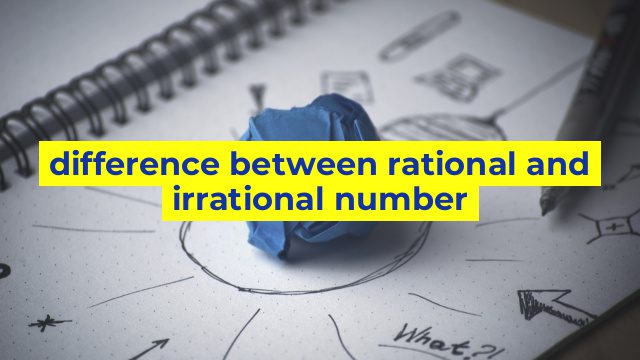Difference Between Rational and Irrational Numbers
What are Rational Numbers?
Rational numbers are the numbers that can be represented as the ratio of two integers. They can be expressed in the form of p/q, where p and q are integers and q is not equal to zero. For example, 4/5, 1/3, and 3/4 are some examples of rational numbers.
What are Irrational Numbers?
Irrational numbers are a type of real number that cannot be represented as the ratio of two integers. These numbers cannot be expressed in fractional form and have an infinite decimal expansion that does not repeat. For example, √2, π (pi), and e (Euler’s number) are some examples of irrational numbers.
Differences Between Rational and Irrational Numbers
The main difference between rational and irrational numbers is that rational numbers can be expressed as a ratio of integers, while irrational numbers cannot. Another significant difference is that rational numbers have either a finite or repeating decimal expansion, while irrational numbers have an infinite, non-repeating decimal expansion.
Rational numbers are easy to work with since they can be expressed as fractions in simplest form, and their decimal form is finite, or it repeats. However, irrational numbers are much more complex and challenging to work with since their decimal expansion is infinite and non-repeating.
Importance of Rational and Irrational Numbers
Rational and irrational numbers are essential in mathematics, and their understanding is crucial in various fields such as engineering, physics, financial modeling, and computer science. They play a fundamental role in number theory, algebra, calculus, and other advanced mathematical concepts.
Moreover, irrational numbers are used to represent the values of many real-life phenomena, such as the ratio of the circumference of a circle to its diameter (π), and the natural growth rate of populations (e).
Conclusion
In summary, rational and irrational numbers are two different types of real numbers with distinct properties. Rational numbers can be expressed as the ratio of two integers and have a finite or repeating decimal expansion, while irrational numbers cannot be expressed as the ratio of two integers and have an infinite and non-repeating decimal expansion. Understanding the differences between rational and irrational numbers is vital for building a strong foundation in mathematics and various other fields.
Table difference between rational and irrational number
| Rational Numbers | Irrational Numbers |
|---|---|
| Rational numbers can be expressed as a quotient or fraction of two integers. | Irrational numbers cannot be expressed as a quotient or fraction of two integers. |
| Rational numbers can be expressed in decimal form, either terminating or repeating. | Irrational numbers have decimal expansions that neither terminate nor repeat. |
| Examples of rational numbers include: 4/5, 0.75, -6/7, 1, and 0. | Examples of irrational numbers include: pi (π), e, √2, φ (phi), and √5. |
| When rational numbers are added, subtracted, or multiplied, the result is always a rational number. | When irrational numbers are added, subtracted, or multiplied, the result may be either rational or irrational. |


